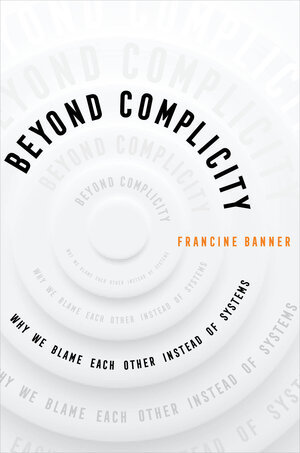What does it mean to be complicit?
This question is at the heart of my book, Beyond Complicity: Why We Blame Each Other Instead of Systems.
My interest in the topic stems from years of practicing and teaching criminal law. Legal scholars generally hate accomplice liability, because it fails to meet the classic elements of criminal law. Accomplice cases leave open questions: What does it mean to help another person commit a crime? Does a defendant have to have wanted the crime to happen, or can willfully ignoring a problem count? What if the helper wished a crime would take place—and tried hard to make it happen—but the assistance they offered failed to make a difference? Loose ends might not matter if the stakes weren’t so high; in the U.S., accomplices can get the same penalty as the primary perpetrator, potentially up to life in prison or the death penalty.
For five years I directed the Women’s Prison Project at the University of Michigan-Dearborn, a program through which faculty offered college courses to hundreds of incarcerated women. As I taught in the prison, I saw firsthand the impact accomplice charges have on women, many of whom come into the criminal justice system after helping a boyfriend commit a crime, or having failed to intervene when a partner abused their children. Like other criminal laws, accomplice charges disproportionately affect non-white defendants, whom jurors are more likely to see as acting “in concert” than white counterparts. They also impact young people, who are often the helpers who “enable” crimes to happen.
As I was seeing the effects of criminal legal complicity on my students, the world was changing. Post-pandemic society is different than it was before. Many of us have experienced individual and collective trauma. We are starting to comprehend the overwhelming risks posed by climate change, the opioid crisis, and wars erupting in Gaza and Ukraine. On a more hopeful note, social movements like #MeToo and Black Lives Matter are bringing heightened awareness to long-obscured and deeply embedded problems of sexism and racism. We seem to have arrived at a liminal moment, a fragile period of transition. But as more of us grow aware of structural problems, there is powerful pushback against social change; it is extremely hard to convince individuals and institutions to take an interest in—let alone to assume responsibility for—something bigger than themselves.
The breadth of complicity is disconcerting. The term is used to describe the actions of incontrovertible harmdoers—the corporations who dump toxic chemicals, the managers who cover up acts by sexual predators. But complicit is also how we might describe an influencer who fails to post in solidarity about a global injustice, or a neighbor who votes differently than we do in a contentious election. “Silence is complicity” is an omnipresent refrain across email signatures and social media. It is a phrase that begs the question: Is silence, really, enough to make someone complicit?
On one hand, investigating complicity can expose relationships between sometimes distant persons or entities that were not visible before. The fear of being labeled complicit can hold corporate and institutional feet to the fire. Complicity is the cornerstone of novel legal theories that are being used to—at long last—hold organizations to account for their roles in facilitating sex trafficking, encouraging troubled young people to purchase firearms, and “turbocharging” the opioid crisis.
But being called out as complicit can lead to isolation, removing a person from the human community without providing a clear path to redemption. There are no guidelines for determining how much punishment is enough, or if and when a transgressor is deserving of being welcomed back into the fold. So far complicity has proven to be a more effective mechanism for implicating supporting players than it has for deterring autocrats and despots.
Conservative lawmakers take full advantage of complicity’s breadth when they pass ordinances that punish aiding and abetting gender-affirming care, laws so broad they potentially forestall the work of hair stylists and librarians. Complicity is the foundation for “bounty-hunter laws” encouraging private citizens to file lawsuits against anyone who lends money to a friend so they can obtain an abortion, or who drives a patient across state lines. As Amy Sepinwall and Michael Dorf point out, alleged concerns about complicity underlie “conscience claims” from employers that refuse to provide employees with insurance that covers reproductive healthcare, and protestations from business owners who refuse to serve LGBTQ+ customers.
I have come to see exploring complicity as akin to unfolding a work of origami, revealing intersecting paths taken and not. The structure may be fragile. If we unfold with too much force, the paper might tear. But in this threshold moment, unfolding existing beliefs and systems is essential, and complicity gives us a tool to do it.
This first appeared on the University of California Press blog.
This post was originally published on this site be sure to check out more of their content.







